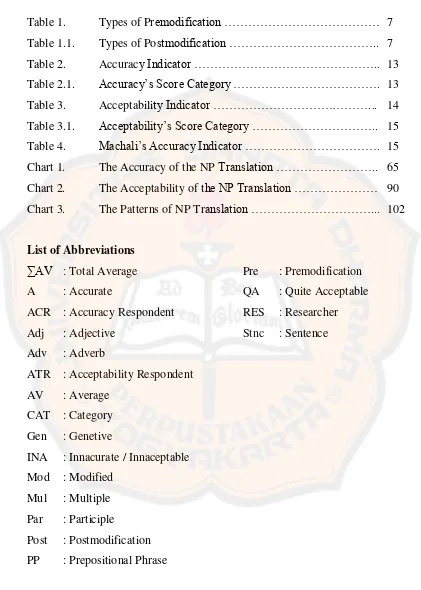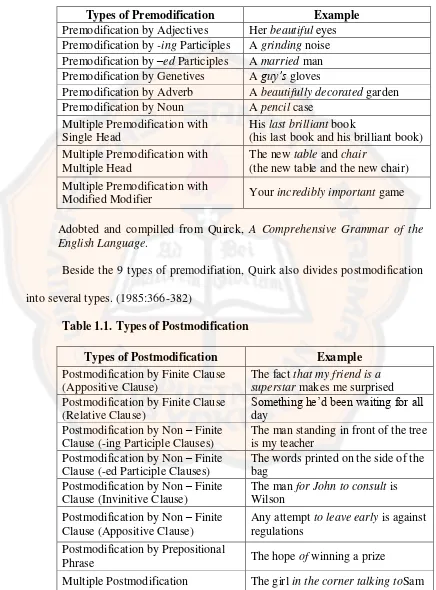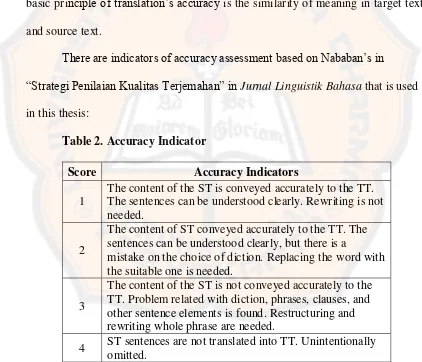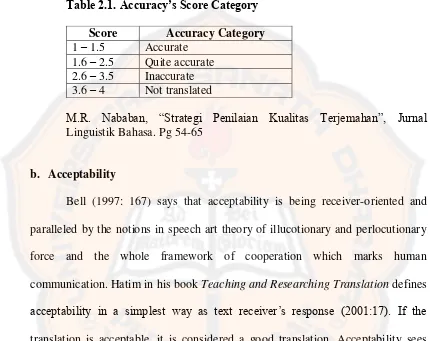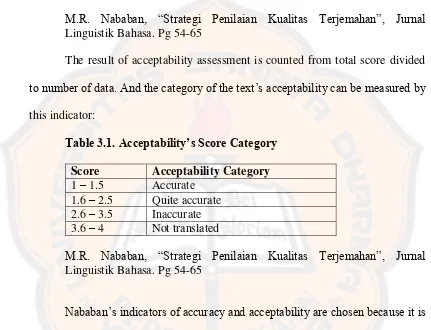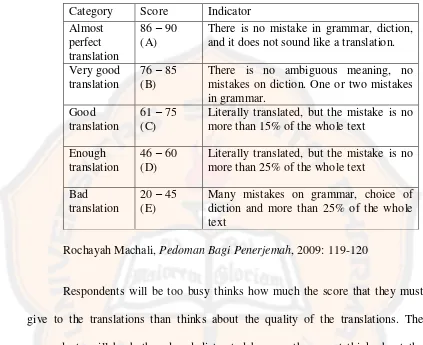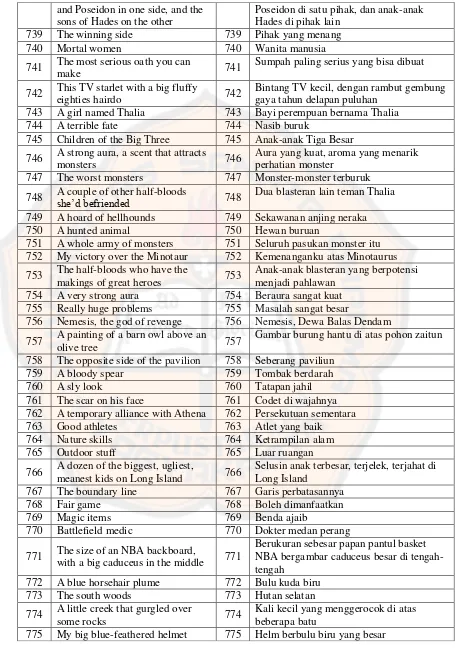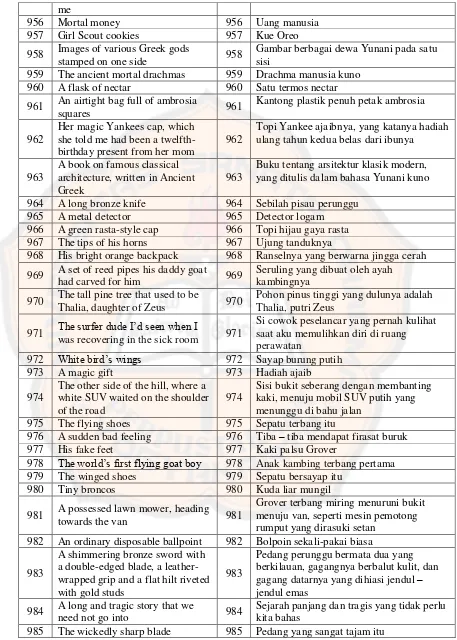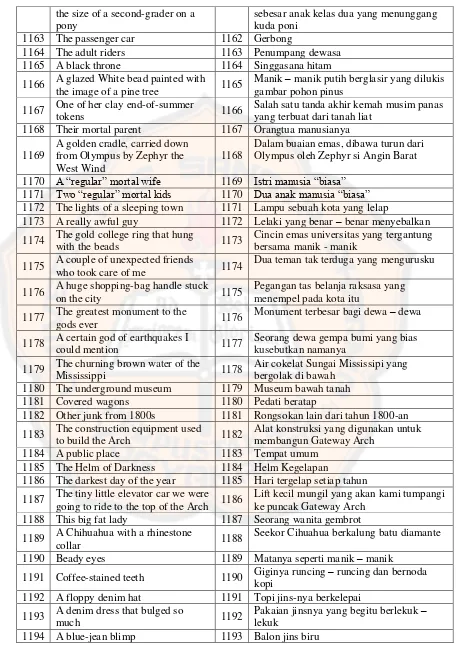THE TRANSLATION OF ENGLISH COMPLEX NOUN PHRASES IN
RICK RIORDAN’S
PERCY JACKSON AND THE OLYMPIANS:
THE LIGHTNING THIEF
INTO BAHASA INDONESIA
A STUDY OF THE PATTERNS GENERATED
AN UNDERGRADUATE THESIS
Presented as Partial Fulfillment of the Requirements
for the Degree of Sarjana Sastra
in English Letters
By
ANTONIUS YOGA PRIA UTAMA
Student Number: 084214025
ENGLISH LETTERS STUDY PROGRAMME
DEPARTMENT OF ENGLISH LETTERS
FACULTY OF LETTERS
SANATA DHARMA UNIVERSITY
i
THE TRANSLATION OF ENGLISH COMPLEX NOUN PHRASES IN
RICK RIORDAN’S
PERCY JACKSON AND THE OLYMPIANS:
THE LIGHTNING THIEF
INTO BAHASA INDONESIA
A STUDY OF THE PATTERNS GENERATED
AN UNDERGRADUATE THESIS
Presented as Partial Fulfillment of the Requirements
for the Degree of Sarjana Sastra
in English Letters
By
ANTONIUS YOGA PRIA UTAMA
Student Number: 084214025
ENGLISH LETTERS STUDY PROGRAMME
DEPARTMENT OF ENGLISH LETTERS
FACULTY OF LETTERS
SANATA DHARMA UNIVERSITY
vi
ACKNOWLEDGEMENTS
First, I would like to thank Jesus Christ, who gives me His blessing every
day. I would say thanks to my beloved parents Anastasia Marsiyem and Stepanus
Sukimin for taking care of me up to now, and my brother Adrianus Fajar Dwi
Prayogo.
I also would say thanks to my advisor J. Harris Hermansyah S., S.S.,
M.Hum., who guides and helps me with his opinion, correction, and experience to
finish this thesis. I would like to thank my co-advisor Adventina Putranti, S. S.,
M. Hum. who helps me to find the mistakes and the lack of the thesis, gives me
opinion and perception to improve this thesis.
I would like to thank my friends, Kurnia Putri, Yuga, Acen, Lando, Rani,
Elfrida Putri, Momon, Blesta, Yeyen, Grety, Vicka, Rinrin, Evi, Yoga, Dama,
Bagas, Dimas, Deni, Simon, and others that I cannot mentions one by one, for the
good times that we shared in the college. I also would say many thanks to English
Letters lecturers and staffs, Ms. Frieda, Ms. Tata, Ms. Anna, Ms. Ari, Ms. Linda,
Mr. Hirmawan, Mr. Tatang, Mbak Ninik, and others. All of you have helped me
to survive in my college life. I would to thank my Rebel Squad and Kontrakan
Family, Roland, Alex, Lembenk, Vian, Christo, Agung, Muje, Nicho for helping
me to refresh my mind after studying.
vii
TABLE OF CONTENTS
TITLE PAGE
………
i
APPROVAL PAGE
……….
ii
ACCEPTANCE PAGE
………
iii
ACKNOWLEDGEMENTS
... vi
TABLE OF CONTENTS
……….
vii
LIST OF TABLES, CHARTS AND ABREVIATION
………..
x
ABSTRACT
………..
xi
ABSTRAK
……….
xii
CHAPTER I: INTRODUCTION
………
1
A. Background
of the Study ………
1
B. Problem Formulat
ion ………..
3
C. Objectives o
f the Study ………..
3
D. Definiti
on of Terms ………
4
CHAPTER II: THEORETICAL REVIEW
………
5
A. Review of Rel
ated Studies ………..
5
B. Review of Re
lated Theories ………
6
1. Theory of Engl
ish Noun Phrase ………..
6
2. Theory of Frasa Nomina
……….
8
3. Theory of Translation
Process……….
11
4. Theory of Translation Assesment………...
13
a.
Accuracy ………..
13
b. Ac
ceptability……….
14
C. Theoretic
al Framework ………..…
17
CHAPTER III: METHODOLOGY
... 18
A. Object of
the Study ………
18
B. Method o
f the Study ………..
19
C. Research
Procedure ………
20
1. Kinds
of Data ……….
20
a. Obje
ctive Data ………
20
b. Affective Data ………
21
2. Data
Collection ………...
23
3. Populat
ion and Sample ………...
25
4. Data
Triangulation ………..
26
5. Data Analysis ……….
27
viii
CHAPTER IV: ANALYSIS
……….
31
A. Translation Acc
uracy of NP ………...
31
1. Premodification by
Adjective ……….. ……..
32
2. Premodifi
cation by Noun ………
36
3. Premodification by Participle (-ing/-
ed) ……….
39
4. Premodificati
on by Genetive ………..
42
5. Premodification by Adverb
……….
43
6. Premodification by Sentence/Phrase
………..
44
7. Multiple Premodific
ation with Single Head………
45
8. Multiple Premodificatio
n with Modified Modifier ………….
47
9. Postmodification by Finite
Clause (Relative Clause) ……….
49
10. Postmodification by Finite C
lause (Appositive Clause) …...
51
11. Postmodification by Non Fi
nite (Participle Clause) ……….
52
12. Postmodification by Non F
inite (Invinitive Clause) ……….
53
13. Postmodification by
Prepositional Phrase ………
54
14. Postmodification b
y Postposed Adjective ………
57
15. Multiple Po
stmodification ………
58
16. Mixed Premodificatio
n and Postmodification ………..
60
B. Translation Acce
ptability of NP ……….
66
1. Premodification by Adjective ……….. ……..
66
2. Premodifi
cation by Noun ………
71
3. Premodification by Participle (-ing/-
ed) ……….
74
4. Premodificati
on by Genetive ………..
75
5. Premodific
ation by Adverb ……….
76
6. Premodification by
Sentence/Phrase ………..
77
7. Multiple Premodific
ation with Single Head………
78
8. Multiple Premodificatio
n with Modified Modifier ………....
80
9. Postmodification by Finite
Clause (Relative Clause) ……….
81
10. Postmodification by Finite Clause (A
ppositive Clause) …...
83
11. Postmodification by Non Fi
nite (Participle Clause) ……….
83
12. Postmodification by Non F
inite (Invinitive Clause) ……….
84
13. Postmodification by
Prepositional Phrase ………
85
14. Postmodification by Postposed Adjectiv
e ………
86
15. Multiple P
ostmodification ………
87
16. Mixed Premodification and Postmodif
ication ……….
88
C. The Patterns of
the Translation ………..
91
1. Head
+ modifier ………..
91
2. Head + yang + modifier
……….
93
3. Not Literally Tr
anslated ……….
94
4. NP to
VP ……… ………
95
5. Head + ber +
Modifier ………
97
6. Head + nya + M
odifier ………...
98
7. Head + Modifier + dan +
Modifier ………
99
8. Cutting the Noun Phrase in
to Several Sentences ………
99
ix
CHAPTER V: CONCLUSION
……….
103
BIBLIOGRAPHY
………..
105
APPENDICES
... 107
Appendix 1
………
. 107
Appendix 2
... 164
x
List of Tables and Charts
Table 1.
Types of Pr
emodification ………
7
Table 1.1.
Types of Po
stmodification ………..
7
Table 2.
Accurac
y Indicator ………..
13
Table 2.1.
Accuracy‟s Score Category ……….
13
Table 3.
Acceptabili
ty Indicator ………...
14
Table 3.1.
Acceptability‟s Score Category ………..
15
Table 4.
Machali‟s Accuracy Indicator ……….
15
Chart 1.
The Accuracy of the NP
Translation ………..
65
Chart 2.
The Acceptability of t
he NP Translation ………
90
Chart 3.
The Patterns of NP Tr
anslation ………...
102
List of Abbreviations
∑AV
:
Total Average
Pre
: Premodification
A
: Accurate
QA
: Quite Acceptable
ACR : Accuracy Respondent
RES : Researcher
Adj
: Adjective
Stnc : Sentence
Adv
: Adverb
ATR : Acceptability Respondent
AV
: Average
CAT : Category
Gen
: Genetive
INA : Innacurate / Innaceptable
Mod : Modified
Mul
: Multiple
Par
: Participle
xi
ABSTRACT
ANTONIUS YOGA PRIA UTAMA.
The Translation of English Complex Noun
Phrases in Rick Riordan’s Percy Jackson and The O
lympians: The Lightning
Thief into The Indonesian Complex Noun Phrase: A Study of The Patterns
Generated.
Yogyakarta; Department of English Letters, Faculty of Letters, Sanata
Dharma University. 2012.
This undergraduate thesis is focused on the accuracy, the acceptability,
and the appropriate patterns based on the accuracy and the acceptability from the
translation of the complex noun phrase in
Rick Riordan‟s Percy Jackson and the
Olympians: the Lightning Thief which is translated by Femmy Syahrani. There are
many complex noun phrases found in the book. The Noun Phrases have many
forms in the ST and TT, and it is interesting to be analyzed.
There are three problems which are analyzed in this thesis. The first
problem is how accurate the Indonesian translations of English complex noun
phrases in Rick Riordan‟s
Percy Jackson and the Lightning Thief are. The second
is how acceptable the Indonesian translations of English complex noun phrases in
Rick Riordan‟s
Percy Jackson and the Lightning Thief are. The third is what the
appropriate patterns for translating NP which are generated from the translation
based on the accuracy and acceptability analysis are.
This study uses the combination of library and field research. The field
research is used to find out the accuracy and the acceptability of the translation in
the Percy Jackson and the Olympians: The Lightning Thief through questionnaire.
The indicator which is used to assess the
questionnaire is Nababan‟s accuracy and
acceptability category. The library method is needed to obtain extra information
about concept and theories that could support this thesis.
xii
ABSTRAK
ANTONIUS YOGA PRIA UTAMA.
The Translation of English Complex Noun
Phrases in Rick Riordan’s Percy Jackson and The Olympians: The Lightning
Thief into The Indonesian Complex Noun Phrase: A Study of The Patterns
Generated.
Yogyakarta; Jurusan Sastra Inggris, Universitas Sanata Dharma. 2012.
Skripsi ini berfokus pada keakuratan, keberterimaan dan pola yang cocok
berdasarkan keakuratan dan keberterimaan terjemahan frasa nomina dari
Rick
Riordan‟s Percy Jackson and the Olympians: the Lightning Thief
yang
diterjemahkan oleh Femmy Syahrani. Di dalam novel ini, terdapat banyak frasa
nomina. Frasa
–
frasa nomina tersebut memiliki banyak bentuk di Teks Sumber
maupun di Teks Target yang menarik untuk diteliti
Ada tiga rumusan masalah yang dibahas di skripsi ini. Masalah pertama
adalah seberapa akurat terjemahan Indonesia dari frasa nomina bahasa Inggris di
Rick Riordan‟s
Percy Jackson and the Lightning Thief. Kedua, seberapa besar
tingkat keberterimaan terjemahan Indonesia dari kata benda bahasa Inggris di
Rick Riordan‟s
Percy Jackson and the Lightning Thief. Ketiga, pola apa yang
cocok untuk menerjemahkan frasa nomina berdasarkan hasil analisis keakuratan
dan keberterimaan dari terjemahan tersebut.
Penelitian ini menggunakan gabungan dari studi lapangan dan studi
pustaka. Studi lapangan digunakan untuk menemukan keakuratan dan
keberterimaan terjemahan di
Percy Jackson and the Olympians: The Lightning
Thief
lewat kuesioner. Indikator yang digunakan sebagai acuan untuk menilai
kuesioner adalah indikator keakuratan dan keberterimaan milik Nababan. Studi
pustaka dibutuhkan untuk mendapatkan informasi lebih tentang konsep dan teori
yang dapat menyokong skripsi ini.
1
CHAPTER I
INTRODUCTION
A.
Background of the study
Nowadays, there are many books in this world. People can easily find any
book they want to read. There are also so many kinds of books like novel, comics,
magazine, and many others. These various kinds of books are found easily around
the world and written in many different languages. Since English becomes an
international language, many texts and books are written in English. It is also used
by many institutions for certain purposes. In Indonesia, English is a well-known
language in many professions. Many English books are translated into Bahasa
Indonesia as the result of the need of the people who want to learn about
technology, economics, politics, culture, and other subjects from foreign
countries. In this case, translation got an important role for communication.
Most of the people in Indonesia do not know English. Since many
important books are written in English, the books need to be translated.
Translating is not an easy job. A translator must have a basic knowledge about
his/her own culture, a mastery of mother-tongue language, a basic knowledge
about theory of translation study and etc.
translation as the abstract concept which encompasses both the process of
translating and the product of that process (1997:19).
People can easily learn about other countries, cultures, politics, habits, and
even the unusual terms that they do not know previously without going to the
country by themselves and without learning the language of the source text (ST).
When people read a translation book, sometimes they will find many terms and
culture that are strange and different from their language
. It becomes translator‟s
duty to translate the terms correctly so that the translation book does not lose the
message that the author wanted to say through some terms.
Each translator has different character when translating something because
of different background knowledge. The background knowledge of a translator
can affect the result of the translation. Here I find a good novel entitled
Percy
Jackson and the Lightning Thief which has been translated into Indonesian
version. There are many complex noun phrases found in the book. The phrases
have many forms which are unique and interesting. It is worth to be analyzed
because from many forms of the complex noun phrase, the best pattern for
translating complex noun phrase can be revealed.
stop the war of the gods. In his quest, he is accompanied by Anabeth and Grover.
Along the story, they help each other and cover each weakness.
This research is important because the result of the research can be used to
measure whether the translations of the complex noun phrase is good or bad. It
also can become a reference how to translate complex noun phrase in English to
Bahasa Indonesia accurately.
B.
Problem Formulation
The problems are formulated as follows
1.
How is the accuracy of the Indonesian translation of English complex
noun phrases in Rick Riordan‟s
Percy Jackson and the Lightning Thief?
2.
How is the acceptability of the Indonesian translation of English complex
noun phrases in Rick Riordan‟s
Percy Jackson and the Lightning Thief?
3.
What are the appropriate patterns generated from the translation of English
complex noun phrase into Bahasa Indonesia based on the accuracy and
acceptability?
C.
Objective of the Study
There are three objectives of this study. First is to find out the accuracy of
the Indonesian translations of English complex noun phrases in Rick Riordan‟s
Percy Jackson and the Lightning Thief. Second is to measure the acceptability of
the Indonesian translations of English complex noun phrases in Rick Riordan‟s
patterns for translating complex noun phrase, based on the result of the answer in
problem formulation 1 and 2.
D.
Definition of Terms
Complex Noun Phrase
is defined as a noun-phrase structure that has two
or more of these three components:
head, premodificationand postmodification.
(Quirk, A Comprehensive Grammar of the English Language, 1985:383-389)
Accuracy
is defined as the correct transfer of information and evidence of
complete comprehension, the appropriate choice of vocabulary, idiom,
terminology, and register; cohesion, coherence, and organization; accuracy in
technical aspect of punctuation, etc. (Munday, 2008:30)
In the other words, accuracy is the correctness of the transfer of
information form ST to TT.
Acceptability
is defined in
a simplest way as text receiver‟s response and
their obedience to the norms and convections (both linguistic-textual and
literary-aesthetic) which operate in the target system. (Hatim, 2007:117-147)
So, acceptability is a translation assessment that sees the translation text
5
CHAPTER II
THEORETICAL REVIEW
A.
Review of Related Studies
Nofi in her undergraduate thesis entitled
Inaccuracy problems of
translating English Singular-
Plural Forms in Bradman‟s and Chatterton‟s Deadly
Game into Permainan Maut
discusses some nouns and classified them into two,
plural and singular. Then she analyzes the words to find out whether the forms
were translated accurately or not by comparing both novels. In the final step she
analyzes the forms and to find out the better translation. She also doing interview
with the translator and asks question about his translation (2008:25).
From the review studies above, we can see that the above writers discuss
some nouns that are inaccurately translated by the translator because the cultural
bound. In this thesis, the writer discusses the inaccuracy in translating English
complex nouns into Indonesian that can give effects to the original story.
B.
Review of Related Theories
1.
Theory of English Complex Noun Phrase
Quirk in
A Comprehensive Grammar of the English Language
defines
complex noun phrase as a noun-phrase structure that has two or three components
(one of them must be a head) from these three components:
a.
The head
, around which the other components cluster and which
dictates concord and other kinds of congruence with the rest of the
sentence outside the noun phrase.
b.
The premodification
, which comprises all the items placed before the
head
–
notably determiners, adjective and nouns.
For example:
That beautiful girl
Some very expensive office furniture
c.
The postmodification
, comprising all the items placed after the head
–
notably, prepositional phrases, non-finite clauses, and relative clauses.
For example:
The chair by the wall
According to Quirk, thereare 9 types of premodification (1985:383-389).
Table 1. Types of Premodification
Types of Premodification
Example
Premodification by Adjectives
Her beautiful eyes
Premodification by -ing Participles
A grinding noise
Premodification by
–
ed Participles
A married man
Premodification by Genetives
A
guy‟s
gloves
Premodification by Adverb
A beautifully decorated garden
Premodification by Noun
A pencil case
Multiple Premodification with
Single Head
His last brilliant book
(his last book and his brilliant book)
Multiple Premodification with
Multiple Head
The new table and chair
(the new table and the new chair)
Multiple Premodification with
Modified Modifier
Your incredibly important game
Adobted and compilled from Quirck,
A Comprehensive Grammar of the
English Language.
Beside the 9 types of premodifiation, Quirk also divides postmodification
into several types. (1985:366-382)
Table 1.1. Types of Postmodification
Types of Postmodification
Example
Postmodification by Finite Clause
(Appositive Clause)
The fact that my friend is a
superstar makes me surprised
Postmodification by Finite Clause
(Relative Clause)
Something he‟d been waiting for all
day
Postmodification by Non
–
Finite
Clause (-ing Participle Clauses)
The man standing in front of the tree
is my teacher
Postmodification by Non
–
Finite
Clause (-ed Participle Clauses)
The words printed on the side of the
bag
Postmodification by Non
–
Finite
Clause (Invinitive Clause)
The man for John to consult is
Wilson
Postmodification by Non
–
Finite
Clause (Appositive Clause)
Any attempt to leave early is against
regulations
Postmodification by Prepositional
Phrase
The hope of winning a prize
Minor Type of Postmodification
Something strange happened last
night
Adobted and compilled from Quirck,
A Comprehensive Grammar of the
English Language.
There is also a possibility to use both premodification and
postmodification to form a complex noun phrase.
For examples: This awesome collection of Indonesian armor and weapons
Best person in the world
The real reason
I‟d said yes to this challenge
2.
Theory of
Frasa Nomina
(Indonesian Complex Noun Phrase)
In his book,
Tata Bahasa Indonesia: Penggolongan Kata,
Prof. Drs. M
Ramlan said that there are many classifications of words in Bahasa Indonesia. He
quoted a statement from Gorys Keraf that according to the form, kata benda is all
words that contain affixes
ke-an, pe-an, pe-, ke-.
For examples
perumahan,
perbuatan, kecantikan, pelari, jembatan, kehendak, etc. The characteristic of the
noun phrase is it can be extended with words
yang + kata sifat. (Ramlan,
Tata
Bahasa Indonesia: Penggolongan Kata, 1985:45)
According to
Tata Bahasa Baku Bahasa Indonesia, a nomina (noun) like
buku
or other noun can be extended to the left or right (preceded or followed by
modifiers). The left extension (premodification) can occur by putting
pewatas
depan or determiner. For examples:
a.
Dua buah buku
b.
Lima ekor kera
c.
Beberapa butir telur
If there is no other modifier precedes or follows the
inti
(head), a
determiner can be placed after the inti. For examples:
a.
Buku dua buah
b.
Kera lima ekor
c.
Telur beberapa butir
(1988:203)
There are many types of right extension (postmodification) for the head.
First, head can be followed by other noun, but every noun that follow other noun
just modifiy one noun that precedes it. In the sentence “
buku sejarah kebudayaan
Indonesia saya
”, the head is the word
buku, and it precedes the other noun. As
shown above, the word
sejarah just explains about
buku, so does the word
kebudayaan that just explains the word sejarah. (1988:204)
Second, adjective can follow the head.
For examples:
Baju merah saya
Rumah mewah mereka
The order of the words is fixed. The change of the order can change the
meaning of the words. For example the word
baju merah saya (my red T-shirt)
and baju saya merah (my T-shirt is red). (1988:204)
Fourth, the head can be followed by certain verb that can be separated by
yang, untuk, or the other elements. For example:
ban berjalan becomes ban yang
berjalan, kewajiban bekerja becomes kewajiban untuk bekerja, and ruang tunggu
becomes
ruang untuk menunggu. Fifth, the head also can be extended by
appositive. For example: Indonesia, Negara kami yang sangat kami cintai. (1988:
205)
Sixth, the head can be attached by pewatas belakang or postmodifier, that
is preceded by the word yang. For example: masalah yang kita bicarakan kemarin
itu. (1988: 205)
Seventh, the head can be extended by
frasa berpreposisi (Prepositional
Phrase). For example:
petani di Aceh, perjalanan ke Bali and uang untuk
pondokan. (1988:206)
Simple noun phrase or complex noun phrase in Bahasa Indonesia can
experience another morphological process called
reduplikasi (reduplication) and
pembentukan kata majemuk.
The formation of reduplication:
1.
Pengulangan utuh
a.
gunung-gunung
b.
rumah-rumah
c.
siapa-siapa
2.
Pengulangan salin suara
a.
warna-warni
b.
serba-serbi
c.
desas-desus
3.
Pengulangan sebagian
a.
dedaunan
b.
pepohonan
c.
sesajian
4.
Pengulangan yang disertai pengafiksan
a.
batu-batuan
b.
daun-daunan
c.
umbi-umbian
Kata Majemuk is the mixed form of a morpheme and a word, or word and
word that create a new word with new meaning. For example
rumah sakit, tanah
air, darah daging, and etc. (1988:166-169)
3.
Theory of Translation Process
Nababan in Teori Menerjemah Bahasa Inggris defines translation process
as a process of translation as the activities which are done by a translator when
he/she transmits a message from a source language (SL) into a target language
(TL) (1999:24).
Bell in his book „
Translation and Translating:
Theory and Practice‟
into one or more target language (Source Text/ST to Target Text/TT). Although
probably there are big differences in the language of the ST and TT, the
translation must be equivalent. In the other words, the message or idea from the
ST must be conveyed completely and faithfully to the TT. The TT must have the
same meaning as the ST so that it does not lead to misunderstanding. It can be
said that equivalence (accuracy) of ST and TT is the most crucial factor in
translation.
There are three characteristics that must exist in the translation according
to Tytler in Bell (1997: 11). First, translation must be giving the complete ideas of
the source text so there is no different content between source text and target text.
It has to deliver the faithfulness of meaning. Second, the translation must have the
same characters of style and manner of writing with those in source text. And the
last, translation must have the ease of original composition or deliver the original
content of source text.
Here Tytler tries to emphasize that a good translation must represents
complete ideas from the ST. It also must have same manner of writing as in the
ST, and last it should sounds as smooth as possible for the reader (acceptability).
4.
Theory of Translation Assesment
a.
Accuracy
Nida and Taber (1974: 12) define translation as the reproduction in a
receptor language of the closest natural equivalent of the source message, first in
terms of meaning, and secondly in terms of style. The meaning of the target text
should be the same
with the source text so there won‟t be any different
understanding and changing of the content in the target text. It is showed that the
basic pri
nciple of translation‟s accuracy
is the similarity of meaning in target text
and source text.
There are indicators of accuracy assessment based on Nababan‟s in
“Strategi Penilaian Kualitas Terjemahan” in
Jurnal Linguistik Bahasa that is used
in this thesis:
Table 2. Accuracy Indicator
Score
Accuracy Indicators
1
The content of the ST is conveyed accurately to the TT.
The sentences can be understood clearly. Rewriting is not
needed.
2
The content of ST conveyed accurately to the TT. The
sentences can be understood clearly, but there is a
mistake on the choice of diction. Replacing the word with
the suitable one is needed.
3
The content of the ST is not conveyed accurately to the
TT. Problem related with diction, phrases, clauses, and
other sentence elements is found. Restructuring and
rewriting whole phrase are needed.
4
ST sentences are not translated into TT. Unintentionally
omitted.
M.R. Nababan, “Strategi Penilaian Kualitas Terjemahan”, Jurnal
The result of accuracy assessment is counted from total score divided to
number of data. And the category of the text‟s accuracy can be measured by this
indicator:
Table 2.1. Accuracy’s Score Category
M.R. Nababan, “Strategi Penilaian Kualitas Terjemahan”, Jurnal
Linguistik Bahasa. Pg 54-65
b. Acceptability
Bell (1997: 167) says that acceptability is being receiver-oriented and
paralleled by the notions in speech art theory of illucotionary and perlocutionary
force and the whole framework of cooperation which marks human
communication. Hatim in his book Teaching and Researching Translation defines
acceptability in a simplest way as text receiver‟s response (2001:17). If the
translation is acceptable, it is considered a good translation. Acceptability sees
how easily the reader can understand and accept the content of the target text.
There are indicators of acceptability
assessment based on Nababan‟s in
“Strategi Penilaian Kualitas Terjemahan” in
Jurnal Linguistik Bahasa that is used
in this thesis:
Table 3. Acceptability Indicator
Score Acceptablility Indicator
1
The TT text is easy to response. The terms at the
translation can be fully understood by the TL readers.
Score
Accuracy Category
2
The TT text is easy to response. The terms at the
translation cannot be fully understood by the TL readers.
3
The TT text is hard to response. The terms at the
translation cannot be understood by the TL readers
4
The TT text is completely hard to response. The terms at
the translation can‟t be understood or it is not translated.
M.R. Nababan, “Strategi Penilaian Kualitas Terjemahan”, Jurnal
Linguistik Bahasa. Pg 54-65
The result of acceptability assessment is counted from total score divided
to number of data. And the category of the text‟s acceptability can be measured by
this indicator:
Table 3.1. Acceptability’s Score Category
Score
Acceptability Category
1
–
1.5
Accurate
1.6
–
2.5
Quite accurate
2.6
–
3.5
Inaccurate
3.6
–
4
Not translated
M.R. Nababan, “Strategi Penilaian Kualitas Terjemahan”, Jurnal
Linguistik Bahasa. Pg 54-65
Nababan‟s indicators of accuracy and acceptability are chosen because it is
This is the example of Machali‟s Indicator:
Table 4. Machali’s Accuracy Indicator
Category
Score
Indicator
Almost
perfect
translation
86
–
90
(A)
There is no mistake in grammar, diction,
and it does not sound like a translation.
Very good
translation
76
–
85
(B)
There is no ambiguous meaning, no
mistakes on diction. One or two mistakes
in grammar.
Good
translation
61
–
75
(C)
Literally translated, but the mistake is no
more than 15% of the whole text
Enough
translation
46
–
60
(D)
Literally translated, but the mistake is no
more than 25% of the whole text
Bad
translation
20
–
45
(E)
Many mistakes on grammar, choice of
diction and more than 25% of the whole
text
Rochayah Machali, Pedoman Bagi Penerjemah, 2009: 119-120
rewriting and restructuring because there is a few mistake in the choice of
diction), 3 is a bad translation (need rewriting and restructuring because there is
many mistakes in the choice of diction, grammar, and etc) and the last 4 is a very
bad translation (the translation is considered as not translated yet because many
expression in ST cannot be conveyed in the TT).
C.
Theoretical Framework
The main objectives of the thesis are to analyze the accuracy and the
acceptability of the translated complex noun phrases from English to Indonesian.
Three questions in the problem formulation are the main discussion in this thesis.
The first to measure the accuracyof the complex noun phrases from English to
Indonesian. The second is to measure the acceptability of the translation. The third
is to understand the pattern of the translation of complex noun phrases from
English to Indonesian and find the appropriate patterns for translating complex
noun phrases based on accuracy and acceptability.
To answer the question, writer used theory of complex noun phrase, theory
of translation, theory of accuracy and theory of acceptability.
18
CHAPTER III
METHODOLOGY
A.
Object Of the Study
The main object in this thesis are the entire complex noun phrases in the
novel “Percy Jackson and the Lightning Thief”
as source texts and “
Percy
Jackson and the Olympians: The Lightning Thief (Pencuri Petir)”
as target texts.
The complex noun phrases that are found in the novel are 2060 phrases.
Percy Jackson and the Lightning Thief
is written by Rick Riordan and
published by Puffin Books. This work consists of 22 chapters and 375 pages.
Percy Jackson and the Lightning Thief
is translated into Indonesian by
Femmy Syahrini. The translation is entitled
Percy Jackson and the Olympians:
The Lightning Thief (Pencuri Petir)
and published by PT. Mizan Publika. It
consists of 22 chapters and 455 pages.
This novel is a fantasy adventure novel with the taste of Greek Mythology.
The writer perfectly combines Greek Mythology with the reality that is occurred
in the real world. It talks about the adventure of a demigod (half god) boy named
Percy who is the only one that could stop the war of the gods.This novel contains
many complex noun phrases that are important to build the story.
The second is
Rick Riordan‟s Indonesian version
Percy Jackson and the
Olympians: The Lightning Thief (Pencuri Petir) which is translated by Femmy
Syahrani. It is published by PT. Mizan Publika in May 2010 and consists of 22
chapters and 455 pages. The translation that will be used in the research is the
complex noun phrase that is spreading from first chapter until last chapter.
B.
Method Of the Study
This research was a qualitative research. The data will be served through
descriptive analysis. In a qualitative research, the description in details and in
depth about what really happened in the field of research is aimed (Sutopo,
2002:111). The method used in this study was the combination of library, and
field research.
The field research is an investigation which is carried out in the usual
environtment
where
a
phenomenon
occurred
Respondent were needed to assess the accuracy and the acceptability of the
translation in the questionnaire.
The Library research was needed to obtain extra information about
concept and theories that could support this thesis. The examples of references
were novels, thesis, books, articles, and online references.
C.
Research Procedure
1.
Kinds of Data
a.
Objective Data
postposed adjective (8 phrases), multiple postmodification (21 phrases) and mixed
premodification and postmodfication (445 phrases).
b.
Affective Data
The survey research was done in this thesis to collect the affective data
from respondents. The data was used to keep the validity of the data, because if
just one person who analyzed the data, the validity of the assessment cannot be
obtained. It was done by making questionnaires of translation accuracy and
acceptability. Respondents were asked to answer the questionnaire. The accuracy
questionnaires consisted of the ST and the TT. The respondents were expected to
assess the accuracy of the TT based on the score 1-4 (best-worst) and gave
comments, correction, or suggestion for the translations if they had any. The
acceptability questionnaires only consisted of the TT. Different respondents did
the assessment as the respondents of the accuracy questionnaire did.
Professional translators were chosen because indeed they were considered
to have many experiences about translation because this was their job scope. A
Linguistic expert was chosen because they had knowledge about the grammar and
other linguistic aspect that influenced the translation very much. The last, literary
experts were chosen because they had a deep knowledge about the taste, the
aspect and the whole parts of literary works.
The third and the fourth groups were asked to assess the acceptability
questionnaire. According to Newmark, the translator should write within his own
idiolect or his conception of the ST. The translator must not use a word or phrase
that sounds unnatural or artificial to him. The nature of acceptability was the same
as culture of the TT (1981:127). A text was considered as acceptable if the text
could be accepted by the culture of the TT. In my opinion, when a son asked his
father “Do this pen belongs to you? It translated in Indonesian into “Apakah pena
ini m
ilikmu?” It was not acceptable because in the Indonesian culture a son
simply could not call his father or mother with
kamu
because it was lack of
respect. It will be acceptable if the sentence became “Apakah pena ini milik
ayah?”
students were chosen because they were the representative of the target reader and
they had knowledge about the circumstances of the people at their age in the daily
life. PGSD students were chosen because they specialized in teaching kids and
they knew the boundary of the knowledge of the elementary students and what
was allowed and not allowed to be learned by students, since elementary school
students also the target reader of the novel.
2.
Data Collection
The data in this research were taken from the text and questionnaire. The
entire complex noun phrases that were found in the novel were treated as my data.
In order to collect the complex noun phrases from
Percy Jackson and the
Lightning Thief
(ST), understandings about complex noun phrase was very
important in determining what kind of complex noun phrases in ST were.
First, I read the novel in ST and mark the complex noun phrase with
circling and giving numbers to them. I collected the phrases and sentences that
were connected with the complex noun phrases in the ST. Then, I found their
translation in
Percy Jackson and the Olympians: The Lightning Thief (Pencuri
Petir) by using theory of translation.
premodification with modified modifier, Multiple premodification with multiple
head.
(2)
Postmodification:
Postmodification
Finite
relative
clause,
Postmodification Finite appositive, Postmodification non finite participle (-ing
and
–
ed), Postmodification non finite to infinitive, Postmodification by
prepositional phrase, Postposed adjective, Multiple postmodification. (3) Mixed
premodification and postmodfication.
Based on the data that had been categorized, questionnaire was prepared. I
made the tables for both accuracy and acceptability and gave a code for each
sentence.
There was an explanation about the indicator of accuracy and acceptability
in the questionnaire. Here was the example of the coding:
ST/14/ Pre.adj here meant source text number 143 and it was placed in
premodification by adjective categorize. Since the amounts of the data were quite
big, the questionnaire of accuracy and acceptability should be divided into 2 parts
for each. There were accuracy questionnaire part 1 and part 2, and acceptability
questionnaire part 1 and 2. Each part would be assessed by one group of
No
Code
Source Text
Code
Target Text
Score
9
ST/143/
Pre.adj
“I mean,
a
Kindly One in
the school!
Now that we
know for sure,
and they know
too”
(Pg. 19)
TT/143/
Pre.adj
“Maksudku, ada
satu Makhluk
Baik di sekolah
ini! Karena
sekarang kita
sudah tahu
pasti, dan
mereka juga
tahu”
(Pg. 23)
respondents. The respondents would give score to each sentence in the
questionnaire. They also could add their comments, critic, or suggestion for the
translation. The questionnaire tables would be served in the appendixes.
3.
Population and Sample
The object of this research was the complex noun phrase. This research
used the complex noun phrase as the primary data. The populations were taken
from two books which were also the sources of this study; those were Rick
Riordan‟s
Percy Jackson and the Lightning Thief
and its translation in Percy
Jackson and the Olympians: the Lightning Thief (PencuriPetir) translated by
Femmy Syahrini. The population was all words which were complex noun
phrases in the books. Because the amount of the data population was very big,
Krejie-Morgan Method was used to determine the sample size.
Researcher
4.
Data Triangulation
The assessment in the term of accuracy, validity was needed. To obtain the
validity, the assessment of the translation used triangulation technique. There
were three types of triangulation; there were methods triangulation, triangulation
of sources, and analyst triangulation. In this study, the analyst triangulation was
chosen as the method. It was a method that was having two or more persons
independently analyzed the same qualitative data and compared their findings
(Patton, 2002:556-560).
The data of translation accuracy were consulted to 3 respondents and the
researcher. They were a translation expert, linguistics expert, and literary expert.
The data of translation acceptability were consulted to 3 respondents and
the researcher. They were an Indonesian literary student, a high school student,
and a student of elementary school teacher study programs.
Translation Accuracy
Translation Expert
Linguistic Expert
Literary Expert
Translation Acceptability
Indonesian Literary Student
High School Student
